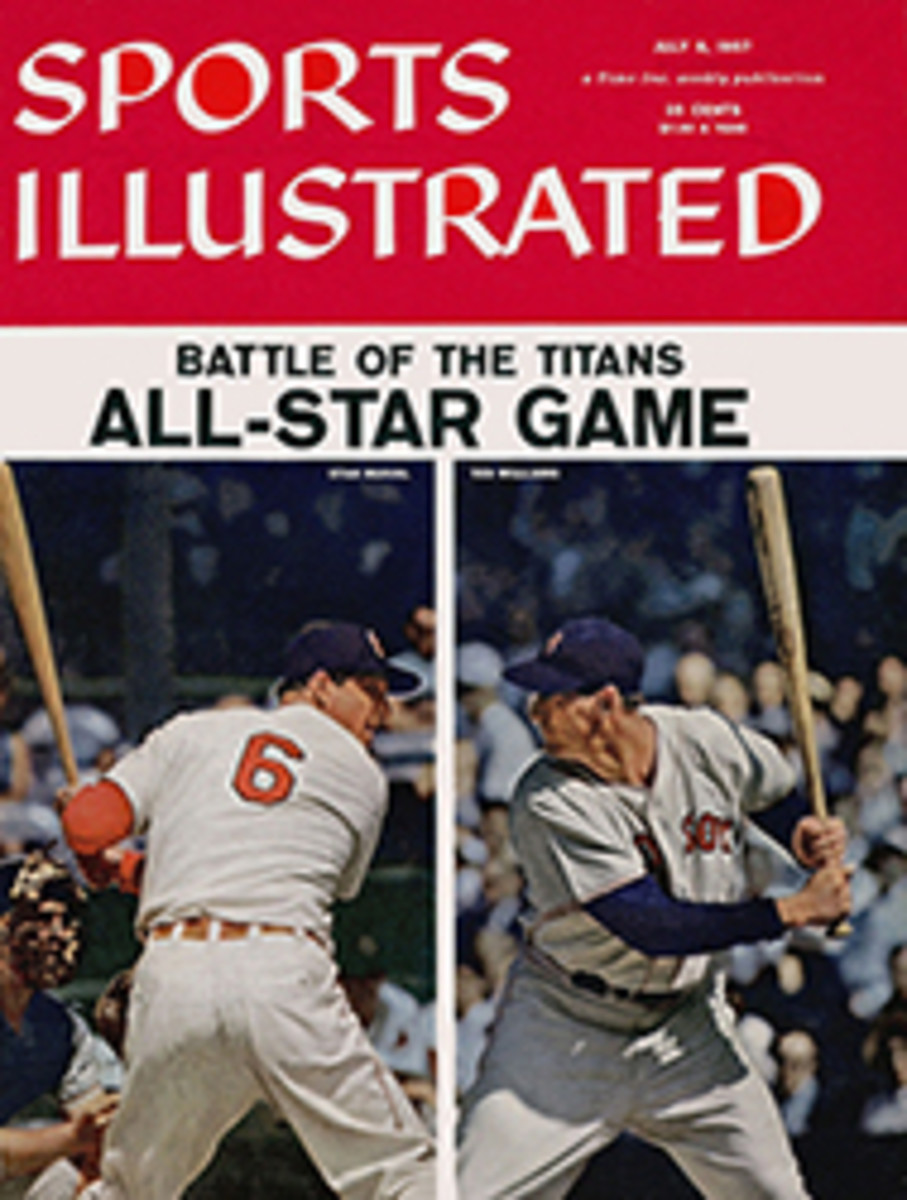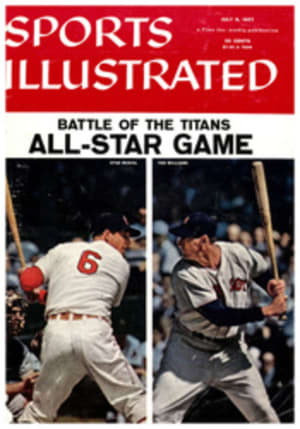
THE FOOTLOOSE SPORTSMAN IN ST. LOUIS
Occupants of the attic seats of Busch Stadium on the ninth of July will not only gaze upon the All-Stars disporting themselves on the field below, but they can look out as well over the fences to the vast verdure of St. Louis, a city bred on bratwurst, bordered by a bend-of the Mississippi and awash in beer.
Here, where the Busches and the Redbirds play and the summer temperatures are reminiscent of the range at home, a visitor can stave off starvation not only through the noble efforts of the wurst dealers displaced from Wuppertal, but also with the help of a battery of hotels, a battalion of restaurant chefs who broil only on charcoal, and a colony of Italians who have long held the heights known locally as The Hill.
A famous outpost on The Hill is Ruggeri's. Ensconced there since 1904, it is now a modern, bright auditorium which lists among its assets chairs for 600, Yogi Berra's brother and a Mighty Wurlitzer organ. Its dimensions make it perhaps the largest steak house west of the Mississippi; Yogi's brother, whose name is John, waits tables there; and the Mighty Wurlitzer once occupied a downtown Loew's theater. At Ruggeri's it bellows nightly under the urgings of one Stan Kann, who also plays three times a day during intermissions at the Fox, six times a day on a local television station and once a week in church. In addition to all this celebrity, tables are also waited by Joe Garagiola's brother Mickey, and the customers' cars are parked by Yogi Berra's father.
Aside from nesting with the Red-birds, Stan Musial also operates a modern green chophouse at 6435 Chippewa, out a bit from downtown, known as Stan Musial and Biggie's. Besides a first-class sirloin strip, visitors can also examine the exhibits, which include gold bats and other honors from the days when Stan led the league (.346 in 1950, .355 in 1951 and .336 in 1952).
A newcomer in the cacciatora circle and an immense hit is Tony's, a low-slung modernistic place which is not on The Hill at all but tucked away in the produce market on Broadway. Although the ceilings were built to scrape the heads of people who started smoking at 4, and there is never a seat without a wait, Tony's reward is a complete $3 Italian dinner including Chianti, and you keep the bottle.
Also on the crumbling fringes of the downtown section is that oldtime, far-famed Hellenic island called the Grecian Garden, presided over by Jim Mertikas. Mertikas, the only remaining Greco-St. Louisan who can boast of working as a busboy with the fabulous Skouras brothers, has catered to the needs of prosperous St. Louisans and famous visitors in good times and dry without letup. Order a glass of masticha to top off your meal and Jim will personally tell you of the great days of the past.
To explorers from other latitudes, St. Louis seems to spread across the full breadth of the Louisiana Purchase, with one cluster of hotels hugging the Statler down toward the river and another group, more residential and resorty, strung out along the fringes of Forest Park. The Statler, the only Hilton hotel in town, is a 650-room extravaganza, orderly and attractive, and like all Statlers complete with a Cafe Rouge and a dark-paneled Terrace Room. Flanking it is the Lennox, which has a downstairs Rathskeller, a brown and beery place where steaks and chops repose on a blanket of shaved ice before being broiled in the open charcoal fire. The perfumes of Bavaria may also be inhaled at the Hofbrau of the Mayfair Hotel, where pretzels are stacked on racks, the waiters are encased in Tyrolean vests and the whole ruddy menu is printed in German. With the Saxons amply provided for, an Anglo can retire to the Mayfair Room which, with its crystal chandeliers, stained glass windows and oils on the wall, is probably the most refined public place in town.
At the edge of the park's precincts is the Forest Park Hotel, which encloses the Surf and Sirloin, so named, I suspect, because it adjoins the hotel's open-air swimming pool and specializes in red meat toasted black. The Frontier Room of the Montclair hotel, also in the vicinity, is planked like some elegant shanty, with wormy chestnut, and specializes, for reasons that escape me, in Cantonese cookery.
The Chase and its appendage, the Park Plaza, both of which face Forest Park, offer a limited version of a Hollywood hotel, especially with the outdoor pool set between the brick towers and screened from the street by hedge. Here, under a statue of a fat cement lady picking her right toe, visiting ball teams loll in beach chairs admiring the visiting airline hostesses promenading down the grass aisles. Next door is a cheerful place called the Steeplechase bar where one Harry Fender, a Ziegfeld star who walked out on Broadway to become a St. Louis city detective, filibusters over the evening air.
NIGHT BIRDS IN AN AERIE
Atop the Chase is a glass aerie where the night birds flit about to music, perching only long enough to contemplate the entertainment or the view across the greenery of Forest Park. Somewhere out there, come nightfall each summer's evening save Sunday, the Municipal Opera presents musical comedy before a tidy hillside audience of 12,000. Back on the crest of the hill, 1,500 free seats are offered every night. The front pews will shortly be air-conditioned, two giant oaks grow onstage and a pair of fog-dispersal machines not only disperse the fog but reduce the humidity.
The other big show in Forest Park is the St. Louis Zoo, one of the nation's most famous. Among its residents is a whopping elephant seal; Phil, largest captive gorilla in the world and one of the few who drink beer; and a tribe of summa cum laude chimpanzees who perform twice daily in their own theater. The show changes every year and, as George Vierheller, the zoo director explains, last year the chimps gave a performance of Show Boat. Recently Gussie Busch donated eight baby elephants, and a regular elephant show, complete with elephants in ballet costumes and hats, will shortly open in a $650,000 elephant house and theater.
Busch's own attraction down by the river is the tidy Anheuser-Busch beer works, which covers 70 square city blocks. Some 100,000 visitors a year filter through to see the malt-mixing, the snake dance of the bottles, and to sample free beakers of Michelob and Budweiser. Grant's Farm, Gussie's home plate farther to the south, attracts 200,000 visitors annually.
Every morning the streamlined steamer Admiral passes the brewery on its way over a six-hour course downriver and back, carrying uncountable youngsters, innumerable pinball games! and an eight-piece jazz band. Moonlight cruises depart nightly at 9 with rock 'n' roll provided by the Mississippi aided by a 13-piece band.
As for forays over dry land, there is a mellow preserve known as Busch's Grove, a half hour from downtown, on Clayton Road, where dinner is served in some 30-odd private screen-and-log houses strewn under the elms. Diners have been strolling under the amber lanterns at Busch's (no kin of the beer Busches) for some 70 years now, and many of their visits were, if not historic, memorable. Lindbergh made hiss first appearance here when he first returned to St. Louis from Le Bourget. Babe Ruth and Connie Mack were there on their final visits to St. Louis, and it was in a summerhouse in Busch's Grove that Alben Barkley first announced his engagement to Mrs. Jane Hadley. Start your meal with their special cottage cheese and you'll see why the place is eternal.
Farther out in St. Charles, some 45 minutes from Broadway, is Wepperich's Wine Garden, a slice of schnitzel from Old Vienna where wine is served on grassy terraces that rise in tiers over the banks of the Missouri. Under an awning of Missouri stars wistful winos sip Liebfraumilch and Medoc while crickets click, cedars nod and a hidden hi-fi sends Franz Josef waltzes winging out across the silver-black river.
The music and the mood are certainly more agitated in the West End along a wide street known as the DeBaliviere strip. For those who find the sin too diluted in St. Louis, there is a settlement over in Illinois, on the left bank of the Mississippi, equipped with bones, bumps and B girls. What I mean to say is, if you seek a seamier side, meet me in East St. Louis, Louis, it ain't so saintly there.

